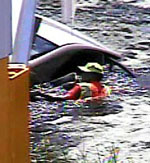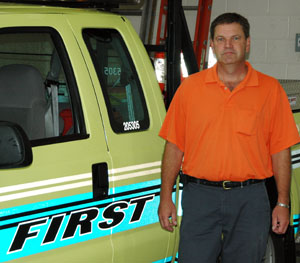|
By Angela Mathis

Video of Don Machacek rescuing a mother and her two kids from a submerged vehicle on July 28. Video courtesy of Regional Transportation Management Center |
Don Machacek, Freeway Incident Response Safety Team, recently rescued a mother and her two children from a car that had veered off Interstate 35W and plunged into a pond just south of 76th Street in Richfield. The incident happened July 28.
Machacek was a few miles north of the incident when he heard the call go out over the radio. Machacek then advised dispatch he was en route and arrived within minutes.
As he drove to the scene, Machacek said he remembers thinking, “It’s not going to be that bad.” He had responded once to a similar call and the water had not been deep. But then he followed the tire tracks, climbed over two fences and saw the car in neck-deep water.
“It was a little worse than the previous incident. I began wondering about the condition of the people in the vehicle—maybe they drove off the road because the driver had a heart attack,” Machacek said. “Someone could have been injured in the crash—I didn’t know.
“When I saw three sets of eyes looking at me from the back window of the car, I took out my hand-held radio and said, ‘I’m going in.’”
Machacek went into the water, opened the car door and helped the family to safety. None of them were injured.
“Machacek’s actions were heroic—he did what needed to be done without hesitation,” said John Lardy, Machacek’s FIRST supervisor. “Still, it probably wasn’t the most dangerous thing he’s done—changing tires and working with traffic at freeway speeds is just as dangerous, if not even more so.”
In their more than 15,000 stops a year, FIRST drivers typically assist the Minnesota State Patrol, move broken-down or crashed vehicles and debris out of traffic, make minor vehicle repairs, help with traffic control, change tires, call tow trucks and supply gas, according to Lardy.

Don Machacek, Freeway Incident Response Safety Team, has worked as a FIRST driver for more than four years. Photo by Nick Carpenter
|
“We get calls for anything that affects traffic,” Lardy said. “Whenever you think you’ve seen it all, something new comes up.”
Machacek has worked as a FIRST driver for more than four years.
“I really like helping people,” Machacek said. “The smile, thanks and appreciation you get from changing a tire or calling a tow truck—it feels good.”
Rescuing the family from the partially submerged car was also “just part of the job,” according to Machacek.
“I’d have done the same thing if I had seen it from my own car,” Machacek said. “To me, it’s not that big of a deal, but my kids, family and dad are so proud.
“I was cutting the grass the other day and several neighbors came over to talk to me about it. It’s been kind of overwhelming.”
For more information about the FIRST program, visit http://www.dot.state.mn.us/rtmc/first/index.html. |



